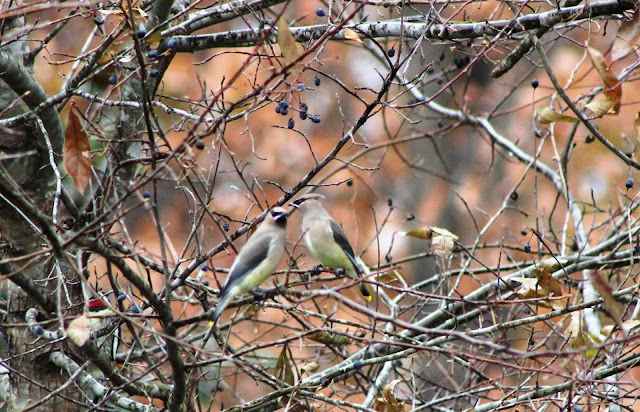When
researchers can’t be everywhere at once, they rely on a crowd sourcing type of
data collection called citizen science.
After training, ordinary citizens can contribute their findings to
research. James River Master Naturalists
participate in many citizen science projects in Powhatan and Goochland. Some members contribute to salamander
studies, bird counts, Easter Spotted Skunk surveys, frog studies and bluebird
monitoring.
After
training, our small group of naturalists set up a new bluebird trail consisting
of eight boxes, for weekly monitoring and data collection. The North American Bluebird Society and
Cornell Laboratory of Ornithology track monitoring efforts and bluebird
population data. Back in the 1970s, the
bluebird population reached a 70 percent decline, mostly due to habitat loss
and competition for nesting cavities from non native species such as house
sparrows and starlings. Today, bluebird
boxes, trails and monitoring have all proven
successful in reestablishing the bluebird population.
Preparation
for the new Powhatan trail began in January, when we
assembled the wood boxes, baffles, poles and hardware. Baffles deter snakes, raccoons and other
predators. Next we scouted
locations with the help of two experienced birders. A bluebird box needs some
open space, afternoon shade in the heat of summer and trees nearby, but no
overhanging branches that might enable a snake to drop down on a box. Finally, our team gathered to
install the boxes.
By mid
February the new bluebird project officially began. Early weekly monitoring reports so far have
been varied. Volunteers have found wasp
nests, a tree swallow nest lined with soft feathers and filled with white eggs,
and a mossy chickadee nest topped with wool from sheep on a nearby farm and filled with eggs. Some bird species simply compete for next
boxes but others will destroy the bluebird eggs or young. Hopefully bluebirds will soon find the six,
new unoccupied boxes awaiting them.
Bluebirds
have two to four broods a season. The
female lays four to six blue eggs. She
lays one a day and when the last egg is laid, she then begins to incubate
them. Eggs hatch about 17 days after the
first one is laid. Nestlings occupy the
nest from 17 to 21 days before fledging.
Old nests should be removed each time a brood fledges. Bluebirds catch and eat insects, although
they will eat berries in winter when fewer insects are available. Both parents catch insects to feed the
young. They also remove the fledglings’
waste, which are small white sacs, to keep the nest clean.
 |
| James River Master Naturalists Susan Brett, Bonnie Schulkers, Kathy Dunn and I assembled and installed bluebird boxes in my wooded neighborhood. |
 |
| The first bluebird box occupants were tree swallows. Photo by Susan Brett. |
 |
| Chickadee eggs in a soft, tidy nest on top of a pile of moss. . Photo by Bonnie Schulkers. |
 |
| Hopefully bluebird eggs like these will soon appear in a box on the new trail. Are there realtors for bluebird houses? |




























